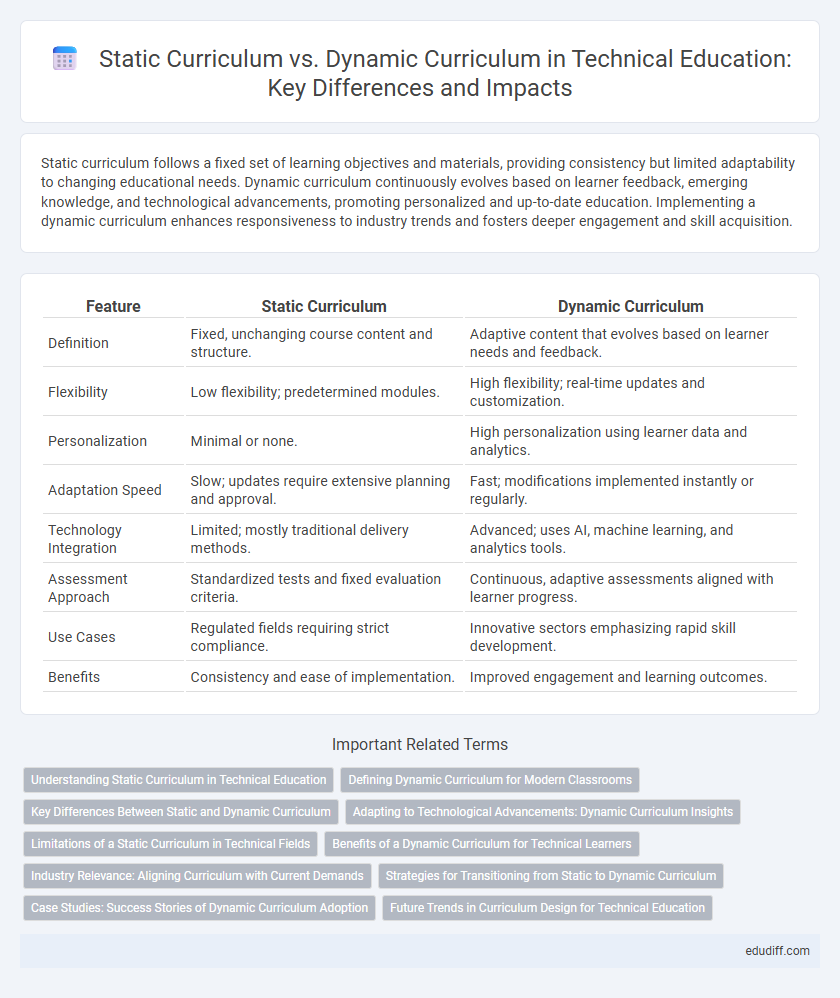Static curriculum follows a fixed set of learning objectives and materials, providing consistency but limited adaptability to changing educational needs. Dynamic curriculum continuously evolves based on learner feedback, emerging knowledge, and technological advancements, promoting personalized and up-to-date education. Implementing a dynamic curriculum enhances responsiveness to industry trends and fosters deeper engagement and skill acquisition.
Table of Comparison
| Feature | Static Curriculum | Dynamic Curriculum |
|---|---|---|
| Definition | Fixed, unchanging course content and structure. | Adaptive content that evolves based on learner needs and feedback. |
| Flexibility | Low flexibility; predetermined modules. | High flexibility; real-time updates and customization. |
| Personalization | Minimal or none. | High personalization using learner data and analytics. |
| Adaptation Speed | Slow; updates require extensive planning and approval. | Fast; modifications implemented instantly or regularly. |
| Technology Integration | Limited; mostly traditional delivery methods. | Advanced; uses AI, machine learning, and analytics tools. |
| Assessment Approach | Standardized tests and fixed evaluation criteria. | Continuous, adaptive assessments aligned with learner progress. |
| Use Cases | Regulated fields requiring strict compliance. | Innovative sectors emphasizing rapid skill development. |
| Benefits | Consistency and ease of implementation. | Improved engagement and learning outcomes. |
Understanding Static Curriculum in Technical Education
Static curriculum in technical education consists of a fixed set of courses and learning outcomes designed to provide consistent foundational knowledge over time. This curriculum model emphasizes stability and uniformity, enabling standardized assessment and streamlined resource allocation across educational institutions. Understanding static curriculum helps educators maintain rigorous academic standards while focusing on core technical competencies without frequent modifications.
Defining Dynamic Curriculum for Modern Classrooms
Dynamic Curriculum in modern classrooms adapts continuously to students' evolving needs, integrating real-time data and personalized learning paths. Unlike static curricula, which follow fixed content and timelines, dynamic curricula emphasize flexibility, modularity, and responsiveness, supporting differentiated instruction and active learner engagement. This approach leverages technology and ongoing assessment to optimize educational outcomes and foster critical thinking skills.
Key Differences Between Static and Dynamic Curriculum
Static curriculum features a fixed, unchanging structure with predetermined content and learning outcomes, emphasizing consistency and standardization. Dynamic curriculum adapts in real-time to student needs, integrating continuous feedback and evolving content to enhance engagement and learning effectiveness. Key differences include flexibility, responsiveness to learner progress, and the ability to incorporate emerging knowledge or skills.
Adapting to Technological Advancements: Dynamic Curriculum Insights
Dynamic curriculum frameworks prioritize continuous integration of emerging technologies, enabling educational programs to promptly incorporate advancements such as AI, IoT, and blockchain. Unlike static curricula, which often lag behind rapid technological changes, dynamic models utilize real-time feedback and industry collaboration to update course content, fostering relevant skill acquisition. This adaptive approach enhances learner readiness for evolving tech environments by aligning education with current and future industry standards.
Limitations of a Static Curriculum in Technical Fields
Static curriculums in technical fields often fail to keep pace with rapid technological advancements, leading to outdated knowledge and skills among students. The rigidity of a static curriculum limits the incorporation of emerging tools, programming languages, and methodologies essential for industry relevance. This inflexibility can hinder the development of adaptive problem-solving abilities critical for innovation in technology-driven careers.
Benefits of a Dynamic Curriculum for Technical Learners
A dynamic curriculum adapts to the evolving demands of technology, ensuring learners acquire up-to-date skills relevant to industry trends and innovations. It fosters critical thinking and problem-solving by incorporating real-time feedback and personalized learning paths. This approach enhances learner engagement and better prepares technical professionals for rapid advancements in their fields.
Industry Relevance: Aligning Curriculum with Current Demands
Static curriculum often struggles to keep pace with rapidly evolving industry standards, leading to outdated skills and knowledge. Dynamic curriculum continuously integrates real-time industry feedback and emerging technologies, ensuring learners acquire relevant and practical competencies. This adaptive approach enhances employability by aligning education directly with current market demands and future trends.
Strategies for Transitioning from Static to Dynamic Curriculum
Implementing a dynamic curriculum requires continuous assessment mechanisms and adaptive learning pathways to replace fixed content structures found in static curricula. Leveraging data analytics for real-time feedback and integrating modular course components enhance flexibility and personalized learning experiences. Educators must adopt iterative curriculum design frameworks and incorporate technology-driven tools to facilitate seamless transitions and accommodate evolving educational goals.
Case Studies: Success Stories of Dynamic Curriculum Adoption
Case studies reveal that organizations implementing dynamic curriculum models experience significant improvements in learner engagement and skill retention compared to static curriculum approaches. For example, Adobe's dynamic curriculum, which continuously integrates emerging industry trends and learner feedback, resulted in a 30% increase in course completion rates and a 25% boost in employee productivity. Similarly, the University of Phoenix's adaptive learning platform showed a 40% improvement in student satisfaction by tailoring content to evolving academic requirements and real-time performance analytics.
Future Trends in Curriculum Design for Technical Education
Future trends in curriculum design for technical education emphasize adaptive learning frameworks, integrating real-time industry data to tailor skill development dynamically. Static curriculum models, characterized by fixed content, risk obsolescence in rapidly evolving technological fields, whereas dynamic curricula leverage AI and data analytics to update modules continuously. Embracing modular and competency-based structures ensures alignment with emerging technologies like AI, IoT, and cybersecurity, preparing students for future workforce demands.
Static Curriculum vs Dynamic Curriculum Infographic

 edudiff.com
edudiff.com